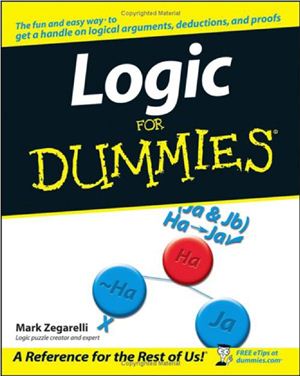Logic has been around a long time — almost 2,400 years and
counting! So, with so many people (past and present) thinking and
writing about logic, you may find it difficult to know where to
begin. But, never fear, I wrote this book with you in mind.
If you’re taking an introductory course in logic, you can supplement your knowledge with this book. Just about everything you’re studying in class is explained here simply, with lots of step-by-step examples. At the same time, if you’re just interested in seeing what logic is all about, this book is also a great place for you to start.
Logic For Dummies is for anybody who wants to know about logic — what it is, where it came from, why it was invented, and even where it may be going. If you’re taking a course in logic, you’ll find the ideas that you’re studying explained clearly, with lots of examples of the types of problems your professor will ask you to do. In this book, I give you an overview of logic in its many forms and provide you with a solid base of knowledge to build upon.
Logic is one of the few areas of study taught in two different college departments: math and philosophy. The reason that logic can fit into two seemingly different categories is historical: Logic was founded by Aristotle and developed by philosophers for centuries. But, about 150 years ago, mathematicians found that logic was an indispensable tool for grounding their work as it became more and more abstract.
One of the most important results of this overlap is formal logic, which takes ideas from philosophical logic and applies them in a mathematical framework. Formal logic is usually taught in philosophy departments as a purely computational (that is, mathematical) pursuit.
When writing this book, I tried to balance both of these aspects of logic. Generally speaking, the book begins where logic began — with philosophy — and ends where it has been taken — in mathematics.
Mark Zegarelli
If you’re taking an introductory course in logic, you can supplement your knowledge with this book. Just about everything you’re studying in class is explained here simply, with lots of step-by-step examples. At the same time, if you’re just interested in seeing what logic is all about, this book is also a great place for you to start.
Logic For Dummies is for anybody who wants to know about logic — what it is, where it came from, why it was invented, and even where it may be going. If you’re taking a course in logic, you’ll find the ideas that you’re studying explained clearly, with lots of examples of the types of problems your professor will ask you to do. In this book, I give you an overview of logic in its many forms and provide you with a solid base of knowledge to build upon.
Logic is one of the few areas of study taught in two different college departments: math and philosophy. The reason that logic can fit into two seemingly different categories is historical: Logic was founded by Aristotle and developed by philosophers for centuries. But, about 150 years ago, mathematicians found that logic was an indispensable tool for grounding their work as it became more and more abstract.
One of the most important results of this overlap is formal logic, which takes ideas from philosophical logic and applies them in a mathematical framework. Formal logic is usually taught in philosophy departments as a purely computational (that is, mathematical) pursuit.
When writing this book, I tried to balance both of these aspects of logic. Generally speaking, the book begins where logic began — with philosophy — and ends where it has been taken — in mathematics.
Mark Zegarelli

